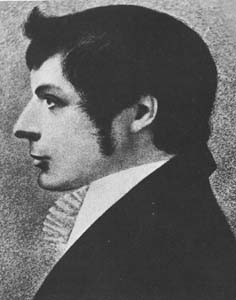| |||||
| Decades: | |||||
|---|---|---|---|---|---|
| See also: | |||||
The following lists events that happened during 1820 in Australia.
| |||||
| Decades: | |||||
|---|---|---|---|---|---|
| See also: | |||||
The following lists events that happened during 1820 in Australia.

John Joseph William Molesworth Oxley was an explorer and surveyor of Australia in the early period of British colonisation. He served as Surveyor General of New South Wales and is perhaps best known for his two expeditions into the interior of New South Wales and his exploration of the Tweed River and the Brisbane River in what is now the state of Queensland.

Major General Lachlan Macquarie, CB was a British Army officer and colonial administrator from Scotland. Macquarie served as the fifth Governor of New South Wales from 1810 to 1821, and had a leading role in the social, economic, and architectural development of the colony. He is considered by historians to have had a crucial influence on the transition of New South Wales from a penal colony to a free settlement and therefore to have played a major role in the shaping of Australian society in the early nineteenth century.

John Joseph Cahill, also known as Joe Cahill or J. J. Cahill, was a long-serving New South Wales politician, railway worker, trade unionist and Labor Party Premier of New South Wales from 1952 to his death in 1959. Born the son of Irish migrants in Redfern, New South Wales, Cahill worked for the New South Wales Government Railways from the age of 16 before joining the Australian Labor Party. Being a prominent unionist organiser, including being dismissed for his role in the 1917 general strike, Cahill was eventually elected to the Parliament of New South Wales for St George in 1925.

Sir James Martin, QC was three times Premier of New South Wales, and Chief Justice of New South Wales from 1873 to 1886.
James Meehan was an Irish Australian explorer and surveyor.
The following lists events that happened during 1810 in Australia.
The following lists events that happened during 1824 in Australia.
The following lists events that happened during 1841 in Australia.
The following lists events that happened during 1821 in Australia.
The following lists events that happened during 1822 in Australia.
The following lists events that happened during 1823 in Australia.
The following lists events that happened during 1825 in Australia.
The following lists events that happened during 1826 in Australia.
The following lists events that happened during 1827 in Australia.
The following lists events that happened during 1840 in Australia.
The following lists events that happened during 1843 in Australia.
The following lists events that happened during 1850 in Australia.

St Luke's Anglican Church is a heritage-listed Anglican church at Elizabeth Drive, Liverpool, Sydney, New South Wales, Australia. It was designed by Francis Greenway and built from 1818 to 1820. The property is owned by the Anglican Parish of Liverpool and is the oldest still existing Anglican church in Australia. It was added to the New South Wales State Heritage Register on 2 April 1999.

St John's Roman Catholic Church and Cemetery is a heritage-listed former school and now Roman Catholic church building located in George Street in Campbelltown. It was designed by John Joseph Therry and built from 1824 to 1841. It is also known as St Johns Roman Catholic Church and Cemetery (former), Saint Johns Roman Catholic Church and Old St John's Church. It was added to the New South Wales State Heritage Register on 2 April 1999. The current church, called St John the Evangelist Catholic Church was built in 1886 and is located at Cordeaux Street, Campbelltown in the City of Campbelltown local government area of New South Wales, Australia. The property is owned by Trustees of the Roman Catholic Church for the Diocese of Wollongong.

Burigon, also called Burragong or Jack, was an Awabakal man and "Chief of the Newcastle Tribe". Alongside his tribe, Burigon entertained Governor Macquarie with a corroboree at the site of the Newcastle Government House. Under the patronage of Commandant James Wallis, who was in charge of the British colonial post of Newcastle from 1816 to 1818, the convict artist Joseph Lycett painted at least 14 scenes of traditional practices of the Awabakal people. Burigon and James Wallis hunted together and Wallis was to later write that he had "kinder feelings" for Burigon than for many of his own heritage. This close relationship of Burigon and Wallis was instrumental in gaining access for the artist Joseph Lycett to visually document the life of the Awabakal people.